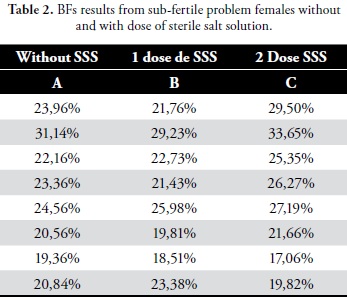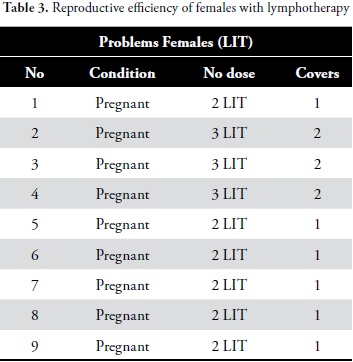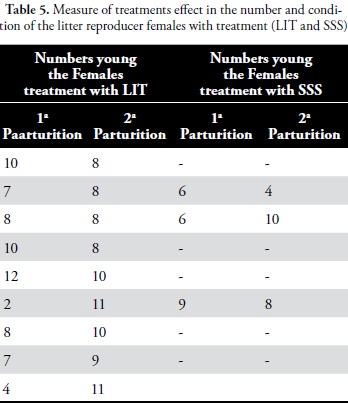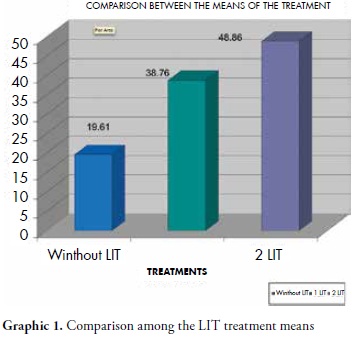Services on Demand
Journal
Article
Indicators
-
 Cited by SciELO
Cited by SciELO -
 Access statistics
Access statistics
Related links
-
 Cited by Google
Cited by Google -
 Similars in
SciELO
Similars in
SciELO -
 Similars in Google
Similars in Google
Share
Nova
Print version ISSN 1794-2470
Nova vol.11 no.19 Bogotá Jan./June 2013
Lymphotherapy induce an increase of blocking factors and correct infertility problems
La Linfoterapia induce aumento de factores bloqueadores y corrige problemas de infertilidad
Edwin Manrique1, Verónica Rincón Humberto Ossa2
1 Universidad Distrital Francisco José de Caldas. Bogotá, D.C. Colombia.
2 Laboratory of Genetic and Molecular Biology. Bogotá, D.C. Colombia.
Correspondence: man-75@uolmail.com / hossa@elsitio.net.com
Recibido: 26/04/2013 Aceptado: 18/05/2013
ABSTRACT
This study aimed to confirm the presence of Blocking Factors (BFs) in Mixed Lymphocyte Culture (MLC) from female normal reproducer and sub-fertile rabbit inoculated with two injection of the allogenic lymphotherapy (LIT) to analyze its effect on rate fertility and pregnancy success. The BFs measuring was done intervening MLC with MTT-Formazan non-radioactive technique.
It was demonstrated BFs presence in MLC in female rabbit groups. In sub-fertile female reproducers treated with allogenic lymphotherapy a significant increase in the level of FBs after every LIT was observed, as well as a rate fertility increase. Furthermore, it was established that BFs act on cell proliferation inhibiting the MLC of other species, clearly indicating that the inhibit effect of the BFs is inter-specific and no intraspecific as had sustain until now.
Key words: lymphotherapy, blocking factors, mixed lymphocytes culture, subfertiles females rabbit and fetal allograft.
RESUMEN
Esta investigación se basó en un modelo experimental de origen animal, dirigido a comprobar la existencia de factores bloqueadores (FBs) del cultivo mixto de linfocitos (CML) en grupos de conejas reproductoras normales y subfértiles. A los animales de experimentación se les aplicó dos dosis de Linfoterapia (LIT) alogénica, con el fin de analizar sus efectos en el aumento de la tasa de fertilidad y del éxito gestacional. La medición de los FBs se realizó mediante CML con la técnica no radioactiva MTT-Formazan. Se comprobó la existencia de FBs del CML en todos los grupos de conejas estudiados. En conejas reproductoras subfértiles tratadas con LIT alogénica se observó un incremento significativo de los niveles de los FBs después de cada LIT, así como el aumento en la tasa de fertilidad de las mismas. Además, se estableció que los FBs de proliferación celular actúan inhibiendo el CML de otras especies, lo que indica claramente que el efecto inhibitorio de FBs es interespecífico y no intraespecífico como se ha sostenido hasta ahora.
Palabras clave: Linfoterapia, factores bloqueadores, cultivo mixto de linfocitos, Oryctolagus cuniculus, aloinjerto fetal.
INTRODUCTION
In 1994 Beer and Billingham established the bases of the immunology of reproduction. These initial studies demonstrated that the uterus is not a immunology privileged tissue. Furthermore, they postulated different theories to explain the survival of fetal allograft during the pregnancy and established the immunotherapy as treatment to recurrent spontaneous miscarriage (1). Subsequent studies developed on animal models allowed to understand the mechanism responsible of the fetal reabsorptions or habitual aborts in addition to the alloinmunotherapy effects in the reproduction (2, 3).
It is currently accepted that the mothers recognize immunologically to her allogenic embryo and respond strongly to the blastocyst implantation in endometrium. For this reason has been thought that there are factors that regulate or suppress the immunological response against the embryo in development, allowing to success of the placental mammals from mammals perspective (4).
One of main purposes of immunology of reproduction is establish experimental animals models to investigate the phenomenon of the response immune maternal against the fetal allograft. The reproductive efficiency of species for commercial utilization in livestock field have been significantly affected for bad practices of the genetic improvement programs that lead to high levels of endogamy. This has generated a very low fertility rate threatening the rusticity of the others species. The importance of this study is to evaluate the effect of the immunotherapy as treatment for correcting specific problems of fertility.
Blocking Factors (BFs). Molecules that prevent immune rejection of the fetal allograft during pregnancy (5,6).
Lymphoteraphy (LIT) or Immunotheraphy. Ppurified preparation of leukocytes that is administered intradermic. Approximately 50 million cells are inoculated from the father or someone related to him (4).
FetalAllograft : It has been considered that fetus is a semi allograft due that possess 50 % of genetic information derivate from the father. It could express antigens from the father or its owns, which would be susceptible to immune recognition and rejection (3).
Subfertile Females. It have been consider subfertile females those rabbit repeat services, meaning being mount often and not stay pregnant. The cause of the subfertility can aggravate immunne problems for the high level endogamics.
MATERIALS AND METHODS
Control group and problem group for the study. BFs in serum were quantifying from 55 female rabbits. Treatment group consisted of 9 subfertile reproducer rabbits inoculated twice with LIT. 8 subfertile reproducer rabbits injected twice with sterile saline solution (SSS) denominated control group;. 20 nulliparous rabbits (80 days) 10 normal multiparous rabbits and 8 post-parturition normal multiparous were included. Males which have been verified its fertility and were in active condition during time the study were utilized as reproducers. Mononuclear cells were obtaining by puncture intracardiac using a sterile heparinized syringe from New Zealand white (NZW) rabbits that were going to be sacrificed. Serums from females problem and control were drawn blood obtaining from for vein marginal puncture of the ear into pediatrics Vacutainer tube additive-free.
Protocol for setting up of the MLC, with the technical non-radioactive MTT-FORMAZAN. NonRadioactive cell proliferation assay is a colorimetric method to determine the viable cells number in culture. In this assay a tetrazolium compound (3-4,5-dimetyl thiazol-2-hl)-2,5 difenil tetrazo-lium brinide) MTT is bio-reduced by cells to Formazan that is soluble in culture medium inside of the mitochondria. The conversion is done by dehydrogenase enzymes found at the matrix mitochondrial in metabolically active cells (7-9).
The lymphocytes were separated from whole blood by Ficoll-Hypaque gradients (density 1,077) and centrifuge to 3000 m.p.r. for 40 minutes. With a Pasteur sterile pipette, the buffy layer was carefully removed and transferred to another tube and 10 ml RPMI-1640 medium were add, centrifuged for 10 minutes (2000 rpm) this procedure were done twice. The male cells or inducers were treat with Mitomycin C 0,25 mg/ml (for every one ml cells is utilize 0,1 ml of Mitomycin C) during 20 minutes at 37°C. The cells were adjust to a final concentration of 2 x 106 cells/ml with RPMI-1640 medium adjusting the counts in Neubauer chamber and the viability using trypan blue in microscopy 40x.
Preparation of Assay Plates. 30 pl of serum from females rabbits to be tested were added to 100 pl of RPMI-1640 by triplicate. 50pl of responds cells (5000 cells/pl) and 50 pl (5000 cells/pl) induces cells previously inactive with Mitomycin C were added in to each well depending upon the numbers of test. The plate was incubated at 37°C for 72 hours in a humidified 5% CO2 atmosphere.
Absorbance measure and data recording. 15 pl of the dye solution were added to each well and the plate was incubated at 37°C for 4 hours in humidified 5% CO2 atmosphere. After 4 hour 100 pl of the Solubilization/Stop Solution was add to each well.
RESULTS
BFs levels from each rabbit were measured before and after treatment, described table 1 and 2. The proliferative response in presence of serums (from female under study) was assessed in the MLC.
BFs results from control females rabbit were obtained, mean 28,69 %, value considered as reference for normal reproducer females without allogenic Lymphotherapy treatment. For sub-fertile reproducer females the BFs mean was 20,79% without alloimmunotherapy inoculation. BFs value of 38,25% were found after first alloinmunization of sub-fertile reproducer females, after the second lymphotherapy dosage the BFs value were 48,17% and with third dosage the values average were 55,90%. These results indicate a significant increase of the BFs directly proportional to the number of lymphotherapy dosage. Furthermore the lymphotherapy increased the efficiency reproductive level, in other words success pregnancy. Table 3 and 4.
The average BFs for nulliparous females (80 days) was 17.2%, normal multiparous, 30.06% and post-parturition multiparous 44.94%.
It was assessed the effect of each treatment in the number and condition of litter. Were obtained as many females treatment with LIT as the females treatment with SSS, Table 5.
Finally serums from 8 females of different species were tested in human MLC to assess proliferative response. All the samples tested inhibited the positive reaction of MLC Table 6
Statistical Analysis
ANOVA analysis (randomized complete block design) were used to evaluate the effect of lymphotherapy in the increasing of BFs in sub-fertile reproducers females compare with sub-fertile females group treated with salt solution. (10,11). Using the ANOVA results significance or the average-to-average method comparisons were carried out applying Tukey’s multiple comparison tests (11).
Statistically significant differences were found for the group treated with lymphotherapy and highly significant between the moment without lymphotherapy and after second lymphotherapy dosage, Table 7 and graphic 1.
There were no statistically significant differences in outcome for treatment group with SSS, therefore all treatment have the same effect, Table 8 and Graphic 2.
DISCUSSION
Due to the different theories proposed to explain the fetal allograft survival various research groups had been focus their effort in study in depth the main role of BFs in preventing the immune rejection of the mother against fetus. For this reason the BFs in sub-fertile reproducer rabbit were studied. The main goal was quantify the BFs of the MLC in animal models which could bring out new information that could being applied in human reproduction especially in reproductive problems with immunologic origin that cause frequent miscarriages.
In this study the lymphotherapy effect in the increasing BFs levels was studied and consequently the greatest pregnancy success chance in comparison with the SSS treatment group in t sub-fertile reproducer rabbits.
The results showed that there is a concentration increase of BFs from MLC after each lymphocytes injection in sub-fertile females. That supports the initial hypothesis since differences highly significant were find between females without lymphotherapy and females after second injection of lymphotherapy (p>0.01). In contrast there not found differences among females treated with SSS (p<0.05). Which indicate that the lymphotherapy is useful for increasing the BFs levels and consequently correct specific cases of infertility being an extremely useful immune therapy in case of recurrent miscarriages in human(12-14) or other mammals. Furthermore, none harmful effect of the lymphotherapy were observed in that species. Contrary to other studies that sustain that lymphotherapy is not treatment that improve the pregnancy success in women with recurrent miscarriages. These results could be were linked to psychology hormones mediated effect (12,13).
The rate fertility success observed in sub-fertile females treated with LIT was greater than the rate in females treated with SSS. The incidence of the LIT was clear since 66% of the females got pregnant at the second LIT injection and the outcome were the 100% at the third injection. The BFs levels were optimal at the third LIT injection where highly significant differences (p>0.01) were observed between females without LIT and females that received up to three LIT injections.
Moreover, it was showed that the pregnancy efficiency was closely tied to good level of BFs. The litter size depended of a lot external variables such as diet, stress, genetic of the animal and the weaning which is related with the handing of production (13). The variability of the young rabbit’s number went from 1 at 20 per litter being a very random data to take into account as reference of treatment with lymphotherapy. Furthermore, note that prenatal mortality occurs usually in all multiparous species of mammals, such as rabbits, it seems that when there is an excessive number of morulas the normal uterine nutrients supply is insufficient for the survival and can induce death of considerably number of embryos, phenomenon called fetal reabsorption (14-18). Base on the above and the study results the lymphotherapy was associated with the fetal reabsorptions decrease which could indicate that lymphotherapy could prevent the selection of consanguineous embryos. at tuterus level.
The quantification of serums from normal females allowed establish the FBs range levels present in normal females. To get good success pregnancy in this specie the BFs range must fluctuate in levels highest than 30% in average (borderline). In addition, the BFs levels were correlated with the numbers of birth thus the more births the higher levels of BFs were observe for the average the BFs in post-birth females (Mean= 45%). The BFs average in nulliparous females was 17%, suggesting that the BFs increased during the first 10 days and maintained its high levels during the pregnancy.
Moreover, it was demonstrate that BFs not relate to classical antibodies, since serum from several species used in one MLC with the same origin inhibited the positive reaction and cell proliferation in all cases. Thus BFs are inter-specific and not inspecific like has been claimed in other studies.
REFERENCES
1. Beer A, Billingham R.E. The embryo as a transplant. In: A Scientific American. 1974; 230: 36-46. [ Links ]
2. Maldonado J. Efecto de la aloinmunoterapia en la reproducción animal. Tesis de grado como requisito parcial para optar al título de Magíster en Inmunología. Universidad de Antioquía. Facultad de Medicina. 1993. [ Links ]
3. Ossa J, Sánchez F, Cadavid A. Inmunología de la Reproducción. Primera Edición. Imprenta Universidad de Antioquía. Colombia. 1993. 206 p. [ Links ]
4. Ossa H, Benítez A, Cárdenas S, Moreno C.H. Cuantificación de factores bloqueadores del cultivo mixto de linfocitos en mujeres abortadoras habituales tratadas con Linfoterapia. In: Medicina Reproductive. 2000; 3(1): 33-36. [ Links ]
5. Gurka G., Rocklin R.E. Reproductive Immunology. In: JAMA.1987;258 (20): 2983-7. [ Links ]
6. Lancet. Maternal blocking antibodies, the fetal allograft and recurrent abortion. The Lancet. 1983. [ Links ]
7. Mossmann T. Rapid colorimetric assay for cellular growth and survival: Application to proliferation and citotoxicity assays. In: Journal of Immunological Methods. 1983;65: 55-63. [ Links ]
8. PROMEGA. 1994. CELL TITER 96 TM Aqueous Non -Radioactive cell proliferation Assay. Technical Bulletin No 169. [ Links ]
9. PROMEGA. 1995. CELL TITER 96 TM Non - Radioactive cell proliferation Assay. Technical Bulletin No 112. [ Links ]
10. Daniel W. Bioestadística. Base para el análisis de ciencias de la salud. Editorial Uteha. Noriega editores. México. 1997; 878p. [ Links ]
11. Reyes C. 1995. Bioestadística Aplicada. Agronomía, Biología, Química. Editorial Trillas. México. 216p. [ Links ]
12. Mowbray J, Gibbings C; Liddell H; Reginald P; Underwood J; Beard R. Controlled trial of treatment of recurrent spontaneous abortion by immunisation with paternal cells. The Lancet. 1985; 8435: 941-943. [ Links ]
13. Ober C, Karrison T, Odem R; Barnes R, Branch W; Stephenson M, Baron B, Ann M, Scott J, Schreiber J. Mononuclear cell immunisation in prevention of recurrent miscarriages: a randomised trial. The Lancet. 1999; 354: 366-369. [ Links ]
14. Adams C. E. Studies on prenatal mortality in the Rabbit, Oryc-tolagus cuniculus : The amount and distribution of loss before and after implantation. In: Journal. Endocrin. 1960;19: 325-344. [ Links ]
15. Adams C. E. Studies on prenatal mortality in the Rabbit, Oryc-tolagus cuniculus: The effect of transferring varying numbers of eggs. In: Journal of Endocrin. 1962; 24: 471-490. [ Links ]
16. Adams C. E. Maintenance of pregnancy relative to the presence of few embryons in the rabbit. In: Journal of Endocrin. 1970; 48: 243-249. [ Links ]
17. Benitez A., Cardenas. Determinación de factores bloqueadores mediante el cultivo mixto de linfocitos (CML), técnica MTT. Tesis de pregrado. Universidad Distrital Francisco José de Caldas. 2000. [ Links ]
18. Scott Jr, Park M, Edwin S, Brach D. Interpretation of blocking activity in maternal serum depends on the equation used for calculation of mixed lymphocyte culture results. In: Clinical Experimental Immunology.1990;82: 363-368. [ Links ]























